O EXERCÍCIO DA LIBERDADE
Alfredo Jaar
Ana Hatherly
António Barros
António Costa Pinheiro
Augusto de Campos
Barbara Kruger
Ben Vautier
Cildo Meireles
Danh Võ
David Goldblatt
Dorita Castel-Branco
E. M. de Melo e Castro
Fernando J. Ribeiro
Fernando Lanhas
General Idea
Gretta Sarfaty
Guerrilla Girls
James Lee Byars
John Baldessari
Joseph Beuys
Luc Tuymans
Lucia Nogueira
Manoel de Oliveira
Maria Helena Vieira da Silva
Martha Rosler
Miguel Branco
Miroslaw Bałka
Oficina Arara
Patrícia Garrido
Piero Manzoni
Sanja Iveković
Tales Frey
Thomas Schütte
Yoko Ono
3 2
COLEÇÃO DE SERRALVES FORA DE PORTAS FUNDAÇÃO DE SERRALVES MUSEU DE ARTE CONTEMPORÂNEA
For several years now, Serralves has given an increasing importance to its Collection one of Europe’s most relevant in contemporary art displaying it in multiple exhibitions at the Museum and throughout the country.
A fundamental part of this strategy, the Serralves Collection Touring Exhibitions Programme is an initiative aimed at promoting decentralisation and democratisation of access to culture, one of Serralves’ cornerstones. Planned in collaboration with Serralves Founding Municipal Councils and other partner institutions, this programme extends nationwide, bringing wide and diverse audiences closer to contemporary art.
The exhibitions conceived under this programme span generations and artistic practices, actively involving artists featured in the Collection, as well as presenting new acquisitions and previously unseen works, consolidating ties with the artistic community and promoting the construction and dissemination of knowledge about the Collection. Each exhibition is complemented by an educational programme which includes activities aimed at different audiences, such as guided tours, family workshops and training seminars for educators and teachers.
For Serralves Foundation, the celebration of the Founding Municipality protocol with Aveiro City Council in 2017 stands out for the development of some of the most ambitious exhibition projects conceived within the framework of this programme. In 2024, the year in which Aveiro is rightfully the first Portuguese Capital of Culture, it is a great honour for Serralves to strengthen this partnership, contributing to the city’s cultural programming.
Over the past few years, Museu de Aveiro/Santa Joana has been a second home for the Serralves Collection, hosting annual solo and group exhibitions that cross generations and diverse artistic practices, encouraging dialogues around themes that are central to contemporary artistic creation and life in society. Accepting the challenge set by the Municipality, works from the Serralves Collection have been presented in dialogue with works from the outstanding Aveiro Municipality Collection, which served as a motto for the conception of new exhibitions developed in close collaboration with internationally renowned artists such as Julião Sarmento or Pedro Calapez promoting and sharing knowledge around both collections in close ties with the artistic community.
Therefore, it was with enthusiasm and a sense of commitment that we welcomed the challenge set by Aveiro City Council for this very special year: the opportunity to develop an unprecedented exhibition for its programme Aveiro, Portuguese Capital of Culture 2024 as part of the 50th Anniversary Celebrations of 25 April.
It is a privilege for Serralves to contribute to this dual commemoration, integrating the excellent cultural programme developed by the Municipality of Aveiro for this highly relevant year, with the presentation of a vast exhibition celebrating culture and democracy.
Desde há vários anos que Serralves tem vindo a dar importância crescente à sua Coleção, um dos acervos de arte contemporânea mais relevantes da Europa, apresentando-a no Museu e no país, em múltiplas exposições.
Parte fundamental desta estratégia, o Programa Nacional de Itinerâncias da Coleção de Serralves é uma iniciativa que tem como principal objetivo promover a descentralização e democratização do acesso à cultura, sendo atualmente um dos mais importantes pilares da atuação de Serralves. Planeado em colaboração com as Autarquias Fundadoras de Serralves e outras instituições parceiras, este programa abrange todo o território nacional, permitindo o alargamento da rede de acesso e de aproximação de diversos públicos à arte contemporânea.
As exposições concebidas no âmbito deste programa cruzam gerações e práticas artísticas e contam com o envolvimento ativo de diversos artistas representados na Coleção de Serralves, bem como com a apresentação de obras inéditas e de novas aquisições, consolidando laços com a comunidade artística e promovendo a construção e partilha de conhecimento em torno da Coleção. Cada exposição é acompanhada por um programa educativo que contempla atividades dirigidas a diferentes públicos, como visitas orientadas, oficinas para famílias e ações de formação para educadores e professores.
O protocolo de Município Fundador de Serralves celebrado com a Câmara Municipal de Aveiro em 2017 destaca-se pelo desenvolvimento de alguns dos mais ambiciosos projetos expositivos concebidos no contexto deste programa. Em 2024, no ano em que Aveiro é muito justamente a primeira Capital Portuguesa da Cultura, é para Serralves uma grande honra poder aprofundar esta parceria, contribuindo para a programação cultural da cidade.
Ao longo dos últimos anos, o Museu de Aveiro/Santa Joana tem sido uma segunda casa para a Coleção de Serralves, acolhendo anualmente exposições individuais e coletivas que cruzam gerações e práticas artísticas diversas, promovendo diálogos em torno de temas centrais à criação artística contemporânea e à vida em sociedade. Seguindo o repto lançado pelo Município, as obras da Coleção de Serralves têm sido apresentadas em diálogo com obras da notável Coleção do Município de Aveiro, que serviu de mote para a conceção de algumas exposições inéditas, concebidas em estreita colaboração com artistas de renome internacional como Julião Sarmento ou Pedro Calapez, consolidando laços com a comunidade artística e promovendo a construção e partilha de conhecimento em torno de ambas as coleções.
Foi, pois, com entusiasmo e sentido de compromisso que acolhemos o desafio lançado pela Câmara de Aveiro para este ano tão especial: a oportunidade de desenvolver uma exposição inédita para a programação Aveiro, Capital Portuguesa da Cultura 2024, no âmbito das Comemorações dos 50 anos do 25 de Abril. É para Serralves um privilégio poder contribuir para esta dupla celebração, integrando a programação cultural de excelência desenvolvida pelo Município de Aveiro para este ano tão relevante, com a apresentação de uma vasta exposição que celebra a cultura e a democracia.
Ana Pinho
Presidente do Conselho de Administração da Fundação de Serralves
President of the Board of Directors of the Serralves Foundation
5 4
In the year Portugal celebrates the 50th anniversary of the 25 April, Aveiro is the Portuguese Capital of Culture, and we therefore wanted to give more meaning and significance to the work we develop with our esteemed partner Serralves Foundation.
The challenge of jointly conceiving an exhibition dedicated to the celebration of the Conquest of Freedom, based on works of contemporary art, was promptly accepted, and it is with great pleasure that, on this very symbolic date (April 24th, 2024), we present this exhibition to the public.
Under a slogan that is as challenging as it is emancipatory, we invite everyone to experience with us this Exercise of Freedom, in Aveiro. A land graced with the Order of Freedom, a contributor to the Democratic Portugal that we are, fighting and working every day to be a better Country, Europe and World.
No ano em que Portugal celebra os 50 anos do 25 de Abril, Aveiro é Capital Portuguesa da Cultura, e quisemos, por isso, dar mais sentido e significado ao trabalho que desenvolvemos com a nossa bem-querida parceira Fundação de Serralves.
O desafio de concebermos conjuntamente uma exposição dedicada à celebração da Conquista da Liberdade, baseada em obras de arte contemporânea, foi prontamente aceite, e é com enorme alegria que, nesta data tão simbólica (24 de abril de 2024), apresentamos ao público O exercício da liberdade.
Sob um mote tão desafiante quanto emancipador, convidamos Todos a viverem connosco este exercício da liberdade, em Aveiro, terra agraciada com a Ordem da Liberdade, contributiva do Portugal Democrático que Somos, lutando e trabalhando a cada dia para sermos mais e melhor País, Europa e Mundo.
José Ribau Esteves
Presidente da Câmara Municipal de Aveiro
Mayor of Aveiro
7 6
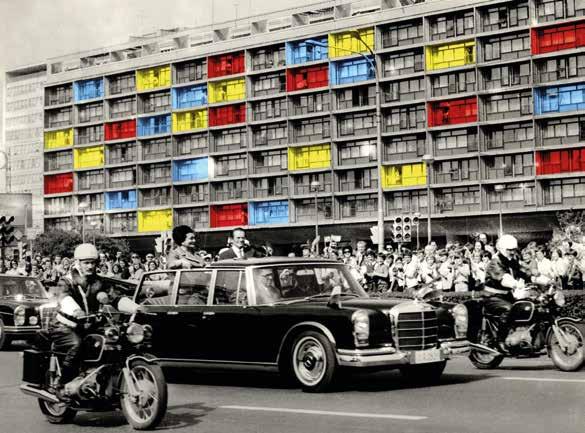
8
SANJA IVEKOVIĆ
Novi Zagreb (Ljudi iza prozora), 1979
No momento em que comemoramos cinquenta anos de democracia, a Fundação de Serralves apresenta uma exposição concebida especificamente para o Museu de Aveiro/Santa Joana que se desenvolve em torno da liberdade enquanto força motriz da criação artística. Integrada na programação Aveiro Capital Portuguesa da Cultura e reunindo obras da Coleção de Serralves e da Coleção do Município de Aveiro, a exposição apresenta trabalhos de artistas que questionam os limites impostos sobre a liberdade individual e coletiva, política e artística, celebrando atos de emancipação, irreverência e subversão de diferentes formas de controlo.
O exercício da liberdade está, de facto, na génese da prática artística, surgindo de mãos dadas com a criatividade e a imaginação. Em conceito, esta exposição poderia então abarcar toda e qualquer manifestação artística e, por isso, toma como mote a celebração do 50.º aniversário da revolução de 25 de Abril, mas não é limitada a expressões artísticas associadas a este importante momento da nossa história, apresentando obras de diferentes tempos, geografias e disciplinas.
Os trabalhos que povoam esta exposição provêm de origens muito distintas, de Portugal ao Vietname, da Croácia à África do Sul, do Brasil ao Japão, e cobrem mais de seis décadas, desde o final dos anos 1950 até aos dias de hoje. Refletindo a diversidade disciplinar característica da arte contemporânea, a exposição integra também as mais variadas práticas, incluindo pintura e escultura, fotografia e desenho, vídeo e performance, pequenos objetos e grandes instalações, cartazes e postais, registos de ações e até de sonhos.
O título da exposição remete para o campo da ação, mais do que para uma mera reflexão sobre o conceito de liberdade: falamos do seu exercício porque há que praticá-la, experimentar os seus contornos sinuosos e questionar os limites que lhe são impostos. Depois de meio século de liberdade, será possível esquecer o que significa viver na sua ausência?
I. A liberdade e o seu contrário
A exposição começa precisamente com um conjunto de obras que evocam a privação de liberdade. O primeiro núcleo é ocupado quase na sua totalidade por uma grande instalação que delimita um espaço central que podemos ver, mas não aceder. No interior desta vedação, de costas voltadas para a entrada da exposição, encontra-se suspensa uma pintura que revela os contornos de uma figura humana à escala real. As bolas de sabão presas à malha da vedação sugerem uma situação de agressão, deixando por adivinhar a origem e o alvo do ataque. Uma obra conjunta de Miroslav Bałka (Varsóvia, Polónia, 1958) e Luc Tuymans (Mortsel, Bélgica, 1958) dois artistas que invocam recorrentemente nas suas práticas o trauma e a memória do Holocausto The Fence [A Vedação] (1998) forja uma relação tensa entre interior e exterior, vigilância e segurança, proteção e clausura.
As obras em redor desta instalação revelam outros gestos de repressão e insubmissão. Do arquivo de Manoel de Oliveira (Porto, 1908 — 2015) apresenta-se documentação relativa ao filme A Caça (1964), cujo final sombrio Oliveira foi obrigado a alterar por imposição da censura, que “exigiu um fim optimista”1. O poema visual Silêncio (1970) do poeta e artista E. M. de Melo e Castro (Covilhã, 1932 São Paulo, Brasil, 2020), aparentemente inofensivo e efetivamente silencioso, terá sido também proibido pela Comissão de Censura em quatro ocasiões distintas2, revelando-se um testemunho notável do potencial revolucionário da arte.
1 Em 1988, por ocasião do restauro da sua curta-metragem A Caça, realizado pela Cinemateca Portuguesa, Oliveira remonta o final do filme, inserindo a seguinte inscrição a poucos minutos do fim da película: “Este filme terminava assim na versão original, mas a censura exigiu o um fim otimista como vão ver a seguir”. Fonte: Cinemateca Portuguesa.
2 Entrevista de Ernesto de Sousa a E. M. de Melo e Castro no contexto da exposição Concepto Incerto na Galeria Buchholz, Lisboa, transmitida no programa “Encontro” da RTP, a 3 de julho de 1976.
11 10
Ana Hatherly (Porto, 1929 Lisboa, 2015), outra figura incontornável da Poesia Experimental Portuguesa3, realizou dezenas de desenhos da série à qual pertence Escritor (c. 1972), num período de enorme “desânimo [e] revolta” face ao sistema político e cultural instituído, surgindo enquanto “representação necessária de um estado de repressão prolongada”. Nas linhas sinuosas e ilegíveis de um destes desenhos, a artista inscreve o seu lamento:
“As palavras descem por sobre a face do poeta como cortinas de água que se fecham sobre a face horrorizada do poeta. o poeta está dentro do lado de dentro ou então fora. o símbolo desce sobre a face descoberta. a face da descoberta. sento-me na minha pequena caixa de vidro que é a página que me isola e me expõe. as palavras ao poeta surgem sobem descem sobretudo nascem. exasperante a lentidão da mão. escrevo tudo isto ilegivelmente porque escrevo o acto de escrever a experiência de o exprimir sem exprimir. isto é tentando isso. descem mil escritas. por onde descem? surgem da ilegibilidade. dum lado leis doutro leis. tudo são regras a transgredir.”4
Encerrando o primeiro núcleo da exposição, os desenhos de Thomas Schütte (Oldenburgo, Alemanha, 1954) que compõem a obra Criminali/7 Portraits [Criminosos/7 Retratos] (1992) guardam uma série de oposições. Apesar de o artista os apresentar enquanto registos prisionais de criminosos, estes desenhos são, na verdade, retratos de pessoas anónimas com que Schütte se terá cruzado na rua e desenhado de memória. Comprometido com o papel social da arte e com o questionamento das convenções que a regem, Schütte convida a uma reflexão sobre as políticas de representação, subvertendo aqui a função tradicional do retrato enquanto género artístico de glorificação, reservado apenas a ilustres e poderosos.
3 Movimento de vanguarda do início da década de 1960 em Portugal, associado a uma tendência internacional de transformação artística e literária que se insurgia contra os constrangimentos narrativos do cânone literário e propunha uma livre experimentação das potencialidades visuais, fonéticas, espaciais e matéricas da linguagem, enquanto forma de expressão poética e artística. Sobre o movimento PO.EX e os seus antecedentes, consultar a brochura da exposição As palavras em liberdade: E. M. de Melo e Castro O Artista e a sua Coleção, Fundação de Serralves, 2022.
4 Ana Hatherly, “Auto-biografia documental”, in Obra Visual 1960 1990, Fundação Calouste Gulbenkian, Centro de Arte Moderna, 1992, p. 85.
II. Livre circulação
O segundo núcleo da exposição é dedicado ao trabalho de artistas que partilham um manifesto compromisso político e espírito democrático, entrosando nas suas práticas temas prementes da esfera pública que condicionam a vida em sociedade. É apresentado um conjunto diverso de múltiplos e edições em diferentes formatos, produzidos em série e distribuídos em circuitos distintos, contrariando a tendência elitista do mercado da arte e contribuindo para a sua aproximação ao quotidiano de um público alargado.
Trabalhos desta natureza assumem com frequência a forma de cartazes, ora reproduzindo obras emblemáticas de artistas como Maria Helena Vieira da Silva (Lisboa, 1908 — Paris, França, 1992) e Augusto de Campos (São Paulo, Brasil, 1931), cujas imagens e palavras de ordem marcaram o fim das ditaduras em Portugal e no Brasil; ora concebidos propositadamente para ocupar as ruas, apropriando o espaço público enquanto espaço de intervenção e resistência, como é o caso dos cartazes produzidos pela Oficina Arara (Porto, 2010) e pelo artista Alfredo Jaar (Santiago, Chile, 1956). Por vezes, estes múltiplos tomam a forma de objetos, como a proveta graduada de Joseph Beuys (Krefeld, 1921 Düsseldorf, Alemanha, 1986) que mede o crescimento de uma rosa, imagem simbólica da transformação gradual da sociedade através da prática criativa que professava o artista; ou as garrafas de Coca-Cola em que Cildo Meireles (Rio de Janeiro, Brasil, 1948) gravava mensagens subversivas, alusivas à ditadura militar brasileira e à sociedade de consumo, que circulavam depois de recolhidas e revendidas pela empresa multinacional. Os postais e selos criados pelos coletivos Guerrilla Girls (Nova Iorque, EUA, 1985) e General Idea (Toronto, Canadá, 1967 1994) assentam também na distribuição alargada própria destes formatos para veicular mensagens de teor político centrais às suas práticas.
13 12
Por outro lado, a artista Sanja Iveković (Zagreb, Croácia, 1949) apropria uma imagem amplamente difundida nos meios de comunicação oficiais da República Socialista da Jugoslávia para nela imprimir um subtil gesto de resistência perante o regime repressivo que marcou a região durante quatro décadas. A artista intervém sobre uma fotografia da visita do Presidente Josip Tito a Zagreb, em 1979, destacando um conjunto de varandas do edifício que surge em plano de fundo onde se distinguem moradores em pé, contrariando as diretivas de segurança ditadas pelo governo.
Nascido no Vietname em 1975, o artista Danh Võ deixou o país com a sua família ainda em criança, fugindo da guerra numa embarcação construída pelo seu pai que, embora tivesse como destino os EUA, foi encontrada por um cargueiro dinamarquês um acaso que levou a família a emigrar para a Dinamarca, onde lhes foi concedido asilo e cidadania. Vivendo hoje entre Berlim e a Cidade do México, Võ traz consigo uma perspetiva singular sobre questões de identidade, migração e pertença. Nesta exposição são apresentadas duas obras da sua mais célebre série, “We the People” [Nós, o Povo]5 (2011), que parte de uma réplica à escala real da superfície da Estátua da Liberdade, fragmentada e dispersa por coleções em todo o mundo, evocando a fragilidade do conceito que o icónico monumento pretende personificar. No caso de Ingots [Lingotes] (2012), o artista funde um destes fragmentos de cobre em lingotes, idênticos a barras de ouro, mas sem o seu brilho particular, tecendo um comentário aos condicionalismos da circulação de arte e a sua dependência do mercado e da acumulação de riqueza.
A relação entre arte e capital está também latente na obra Valor (1977) de António Barros (Funchal, 1953), artista português associado ao movimento Fluxus e à segunda geração de artistas PO.EX, célebre por cruzar linguagem e objeto na
5 Famosas palavras que dão início ao preâmbulo da Constituição dos EUA.
criação de obras de pendor poético, irónico e político. Os seus poemas-objetos, ou objestos, operam uma ressignificação da palavra e do seu suporte partindo da repetição, fragmentação e transmutação de vocábulos como cravos-escravos, revolução-solução, ver-verdade e ignorar-orar.
David Goldblatt (Randfontein, 1930 Joanesburgo, África do Sul, 2018), notável fotógrafo conhecido pelo seu olhar franco sobre a sociedade sul-africana, produziu a série “Particulars” [Particularidades] em 1975, em pleno regime Apartheid. Aparentemente distanciadas da brutalidade do quotidiano da época, estas imagens focam-se em pormenores de corpos de diferentes pessoas que ocupam o espaço público, retratando o posicionamento das suas mãos, torso, pernas ou pés. Apesar de inicialmente ter procurado desenvolver um corpo de trabalho lírico, isento de implicações políticas, o artista rapidamente compreendeu como o regime de segregação e opressão racial surge espelhado nos gestos mais naturais6, na forma como alguém segura a sua carteira ou se senta num banco de jardim. Neste contexto de segregação racial institucionalizada, os planos aproximados de “Particulars” expõem os mais íntimos e mais amplos sinais de desigualdade e repressão, estatuto e privilégio.
III. É proibido proibir
O famoso aforismo Il est interdit d’interdire!, que terá surgido como uma provocação, em tom jocoso, para rapidamente se tornar uma máxima do movimento contestatário francês de Maio de 1968, serve de mote ao terceiro e último núcleo da exposição, centrado no trabalho de artistas para quem a irreverência, o humor e a imaginação são profundamente consequentes. Com astúcia e atrevimento, espírito autocrítico e utópico, estes artistas questionam os constrangimentos de normas sociais vigentes e de qualquer limite imposto à criação artística.
6 Entrevista a David Goldblatt acerca da série “Particulars”, disponível em steidl.de.
15 14
As obras de Gretta Sarfaty (Atenas, Grécia, 1947) e Patrícia Garrido (Lisboa, 1963) exibidas na exposição celebram a sexualidade e o prazer femininos com audácia e humor. Desde a década de 1970, Sarfaty tem explorado a deformação da imagem do seu corpo enquanto lugar de transmutação, investigação exemplarmente ilustrada no tríptico que aqui se apresenta. Rejeitando a iconografia canónica do corpo feminino, perpetuamente objetificado e subjugado pelo olhar masculino, Sarfaty e várias artistas da sua geração reclamam para si o poder de representação e ativação do seu corpo como meio de expressão artística, como agente criativo e político. As esculturas de Patrícia Garrido intituladas O prazer é todo meu (1994) são modeladas em espuma para se adaptarem ao corpo da artista, sendo revestidas a silicone e poliéster em tons rosados que lhes conferem o seu aspeto lascivo e carnal. São esculturas intrigantes que aparentam ter um uso, porque, mais do que “negativos de um corpo”, são objetos de prazer.
Martha Rosler (Nova Iorque, EUA, 1943) e Tales Frey (Catanduva, Brasil, 1982) rejeitam os estereótipos normativos impostos sobre a identidade de género, subvertendo os papéis sociais tradicionalmente prescritos à mulher e ao homem. No seu célebre filme Semiotics of the Kitchen [Semiótica da Cozinha] (1975), Rosler, artista da geração de Gretta Sarfaty, ridiculariza os populares programas culinários transmitidos na televisão, demonstrando com gestos violentos e bizarros a utilização de diferentes utensílios de cozinha. De Tales Frey, artista multidisciplinar com uma prática ancorada na performance, é apresentada a obra Vestido, registo de um projeto performativo que desenvolveu no Porto entre 2014 e 2015, no qual visitou diferentes lojas de vestuário de casamento, procurando em cada ocasião provar um vestido que, segundo o preceito heteronormativo, é tradicionalmente usado pela noiva. Frey documenta as diferentes reações dos lojistas ao seu pedido, que variam de pleno à-vontade a resoluta resistência, vendo-se em algumas situações impedido de o concretizar.
A definição de arte, dos seus contornos, propósitos e limites, tem sido perpetuamente debatida e rebatida, sobretudo pelos seus próprios criadores. Questionar e reinventar a matéria-prima da arte tem entretido artistas há gerações, abrindo caminho para obras como a famosa lata de excrementos de Piero Manzoni (Soncino, 1933 Milão, Itália, 1963) ou a minúscula escultura de FIMO, de Miguel Branco (Castelo Branco, 1963). A linguagem surge também como suporte usual para gestos de emancipação e provocação, seja sob a forma de manifestos, poemas, máximas ou diretivas, como exemplificam as obras de Ben Vautier (Nápoles, Itália, 1935), John Baldessari (National City, 1931 Los Angeles, EUA, 2020) e James Lee Byars (Detroit, EUA, 1932 Cairo, Egito, 1997), que se apoiam no humor e no absurdo para demonstrar que a arte é, afinal, o que o artista assim entender.
Porém, questionar figuras e estruturas de poder significa também pôr em causa a autoridade do artista enquanto génio criativo. Vários artistas partilham com o público a autoria das suas obras, como é o caso de Pele Compulsiva (2000) de Fernando J. Ribeiro (Lisboa, 1963), sendo o objeto modelado pelo artista um mero suporte para a ação performativa dos visitantes, encorajados a riscá-lo com total liberdade. Pioneira da performance participativa, Yoko Ono (Tóquio, Japão, 1933) conta com a destreza física e mental de cada visitante (ou leitor) para completar as instruções que nos deixa no seu célebre livro Grapefruit (1964), muitas delas apenas concretizáveis no campo da imaginação. E é precisamente invocando o universo da imaginação que termina O exercício da liberdade, com o sonho utópico de Fernando Lanhas (Porto, 1923 2012) e as fabulações cósmicas de António Costa Pinheiro (Moura, 1932 Munique, Alemanha, 2015), seguindo o lema que este artista visionário crivou em várias das suas fantásticas obras:
“A imaginação é a nossa liberdade”7.
7 Carimbo com a inscrição “L’imagination est notre liberté” utilizado pelo artista em diversas obras da série na qual se integram os trabalhos apresentados nesta exposição.
17 16

18
OFICINA ARARA
Boca, 2013

ALFREDO JAAR
La cultura de emergència..., n.d. Impressão sobre papel
96 x 67,2 cm
Livros e Edições de Artista. Col. Fundação de Serralves Museu de Arte Contemporânea, Porto. Doação 2009
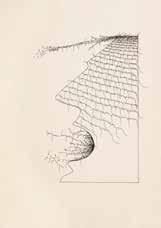
ANA HATHERLY
Escritor, c. 1972
Tinta-da-china sobre papel
35,5 x 25,5 cm
Col. Fundação de Serralves Museu de Arte Contemporânea, Porto.
Aquisição em 1999
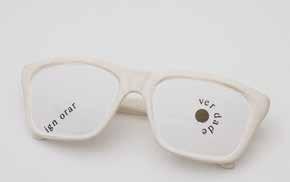
ANTÓNIO BARROS
VerDade, 1977
Óculos de plástico pintados, letras de decalque
4 x 14,5 x 4,5 cm
Col. Fundação de Serralves Museu de Arte Contemporânea, Porto.
Aquisição em 2012

ANTÓNIO BARROS
Valor, 1977
Bolsas de cetim, pedras
10,5 x 11,5 x 3 cm (cada bolsa)
Col. Fundação de Serralves Museu de Arte Contemporânea, Porto.
Aquisição em 2012
21 20
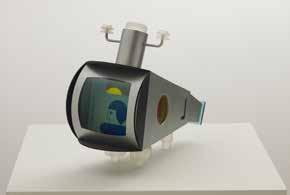
ANTÓNIO COSTA PINHEIRO
Universonaut Raumschiff, c. 1971
Plástico, acrílico, alumínio
17 x 10 x 20,5 cm
Col. Fundação de Serralves Museu de Arte Contemporânea, Porto.
Aquisição em 2009
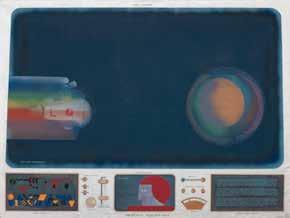
ANTÓNIO COSTA PINHEIRO
Universonauta no Planeta das Poeiras Cósmicas, 1971 – 1973
Óleo sobre tela
150 x 200,8 cm
Col. Fundação de Serralves Museu de Arte Contemporânea, Porto.
Aquisição em 2009

AUGUSTO DE CAMPOS
Pós-tudo, 1984
Impressão sobre papel
40 x 50 cm
Livros e Edições de Artista. Col. Fundação de Serralves Museu de Arte
Contemporânea, Porto. Aquisição em 2005

BARBARA KRUGER
Business of Punishment, 1994
Capa de vinil
31,5 x 31,2 cm
Coleção Particular em depósito na Biblioteca da Fundação de Serralves.
Col. Fundação de Serralves Museu de Arte Contemporânea, Porto.
Depósito em 2007
23 22
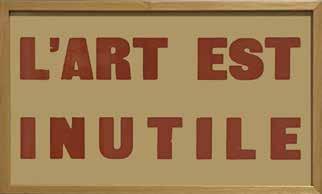
BEN VAUTIER
L’art est inutile, 1968
Impressão sobre papel
28,7 x 49,8 cm
Livros e Edições de Artista. Col. Fundação de Serralves Museu de Arte Contemporânea, Porto. Aquisição em 2002

CILDO MEIRELES
Inserções em Circuitos Ideológicos (Projecto Coca-Cola), 1970
Garrafas de vidro, Coca-Cola (3 elementos)
24,5 x 20 x 5,8 cm
Col. Fundação de Serralves Museu de Arte Contemporânea, Porto. Doação do artista em 2000
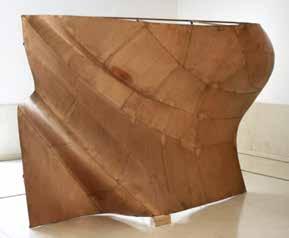
DANH VÕ
We the People (detail), 2011
Cobre
202 x 300 x 80 cm
Col. Fundação de Serralves Museu de Arte Contemporânea, Porto. Aquisição em 2013
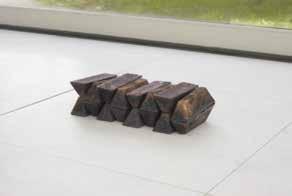
DANH VÕ
Ingots, 2012
Cobre maciço (16 elementos)
17,5 x 35 x 64 cm
Col. Fundação de Serralves Museu de Arte Contemporânea, Porto. Aquisição em 2013
25 24
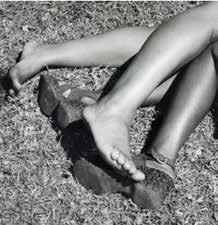
DAVID GOLDBLATT
Women at play during their lunch-hour, Pieter Roos Park, Johannesburg, 1975/2007
Fotografia p/b
47 x 47 cm
Col. Fundação de Serralves Museu de Arte Contemporânea, Porto. Aquisição em 2010
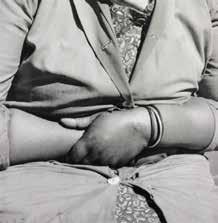
DAVID GOLDBLATT
Child minder, Joubert Park, Johannesburg, 1975/2007
Fotografia p/b
48 x 47 cm
Col. Fundação de Serralves Museu de Arte Contemporânea, Porto. Aquisição em 2010
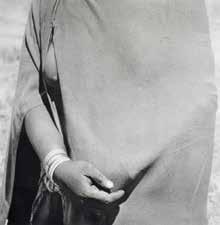
DAVID GOLDBLATT
Woman going to the trading store holding money under her blanket, near Flagstaff, 1975/2007
Fotografia p/b
48 x 47 cm
Col. Fundação de Serralves Museu de Arte Contemporânea, Porto. Aquisição em 2010
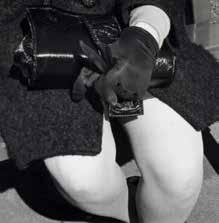
Woman dressed for an occasion, Joubert Park, Johannesburg, 1975/2007
Fotografia p/b
47,5 x 46,5 cm
Col. Fundação de Serralves Museu de Arte Contemporânea, Porto. Aquisição em 2010
27 26
DAVID GOLDBLATT

DAVID GOLDBLATT
Couple on Sunday afternoon, Zoo Lake, Johannesburg, 1975/2007
Fotografia p/b
47,5 x 46,5 cm
Col. Fundação de Serralves Museu de Arte Contemporânea, Porto.
Aquisição em 2010
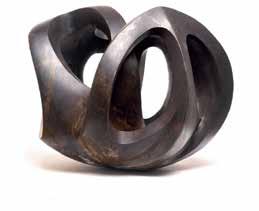
DORITA CASTEL-BRANCO
Metamorfose, 1970
Bronze
35 x 41 x 43,5
Col. Município de Aveiro
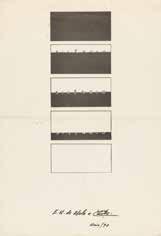
E. M. DE MELO E CASTRO
Silêncio, 1970
Impressão e tinta sobre papel
39,1 x 22 cm
Col. Fundação de Serralves Museu de Arte Contemporânea, Porto. Doação Isabel Alves em 2023
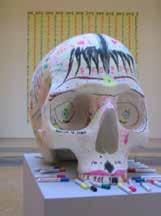
FERNANDO J. RIBEIRO
Pele Compulsiva, 2000
Gesso, madeira, magic markers (marcadores)
120 x 152 x 55 cm
Col. Ivo Martins, em depósito na Fundação de Serralves Museu de Arte Contemporânea, Porto. Depósito em 2004
29 28
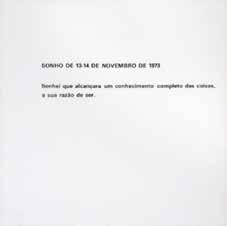
FERNANDO LANHAS
S42, 13-14 de novembro, 1973
Papel fotográfico sobre aglomerado
85 x 85 cm
Col. privada, em depósito na Fundação de Serralves Museu de Arte Contemporânea, Porto. Depósito em 2005
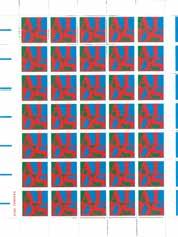
GENERAL IDEA
AIDS (Stamps), 1988
28 x 21,5 cm
Impressão sobre papel
Livros e Edições de Artista. Col. Fundação de Serralves Museu de Arte Contemporânea, Porto. Aquisição em 2004
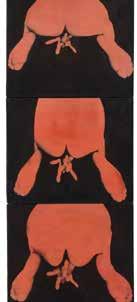
GRETTA SARFATY
A woman’s diary XVIII — Version 2, 1977
Tinta acrílica sobre tela (3 elementos)
150 x 60 cm
Col. Fundação de Serralves Museu de Arte Contemporânea, Porto. Aquisição em 2022

GUERRILLA GIRLS
Guerrilla Girls Greatest Hits, 1993
16 x 12 cm (cada)
Impressão sobre papel (14 postais)
Livros e Edições de Artista. Col. Fundação de Serralves Museu de Arte
Contemporânea, Porto. Aquisição em 2009
31 30
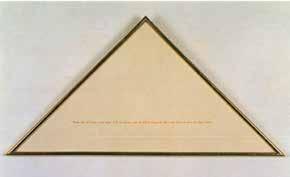
JAMES LEE BYARS
Please limit all talking to the sound of O, as preview given by W.W.S. Antwerp to This is Ghost of James Lee Byars Calling, 1969
Impressão sobre papel, moldura dourada
34 x 94 cm
Col. Fundação de Serralves Museu de Arte Contemporânea, Porto.
Aquisição em 2002
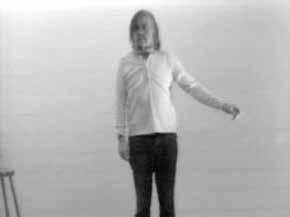
JOHN BALDESSARI
I Am Making Art, 1971
Vídeo, p/b, som, 4:3, PAL, 18’40”
Col. Fundação de Serralves Museu de Arte Contemporânea, Porto.
Aquisição em 1999
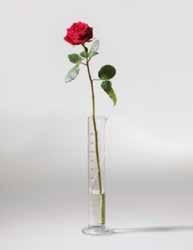
JOSEPH BEUYS
Rose für Direkte Demokratie, 1973
Cilindro de vidro graduado com inscrição, rosa
33,5 x 5 x 5 cm
Col. privada em depósito na Fundação de Serralves Museu de Arte Contemporânea, Porto
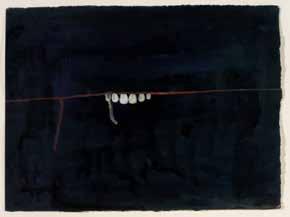
LUCIA NOGUEIRA
Sem título, n.d.
Aguarela e tinta sobre papel
28 x 38 cm
Col. Fundação de Serralves Museu de Arte Contemporânea, Porto.
Aquisição em 2008
33 32
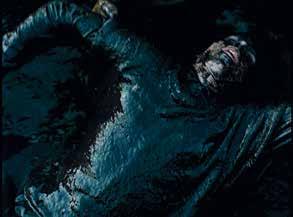
MANOEL DE OLIVEIRA
A Caça, 1963 – 1964
Argumento do filme, fotografias de cena e correspondência (10 elementos)
Dimensões variáveis
Arquivo Manoel de Oliveira, em depósito na Biblioteca de Serralves. Col. Fundação de Serralves Museu de Arte Contemporânea, Porto. Doação
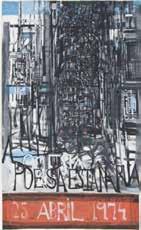
MARIA HELENA VIEIRA DA SILVA
A Poesia está na Rua, 25 de Abril, Lisboa, 1974, n.d.
Impressão sobre papel
98 x 60 cm
Livros e Edições de Artista. Col. Fundação de Serralves Museu de Arte Contemporânea, Porto. Adquisição em 2024
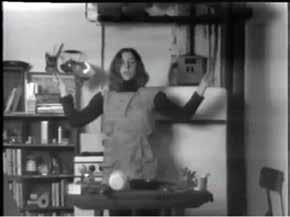
MARTHA ROSLER
Semiotics of the Kitchen, 1975 Vídeo, p/b, som, 4:3, PAL, 5’25”
Col. Fundação de Serralves Museu de Arte Contemporânea, Porto. Aquisição em 1999
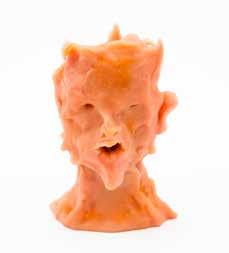
MIGUEL BRANCO
Diabo, 2007
Pasta de modelar FIMO
13 x 9 x 7 cm
Doação do artista à Col. Município de Aveiro
35 34

MIROSLAW BAŁKA, LUC TUYMANS
The Fence, 1998
Ferro, rede de malha de arame, arame farpado, sabão, tinta acrílica sobre tela
270 x 450 x 450 cm
Col. Fundação de Serralves Museu de Arte Contemporânea, Porto.
Doação dos artistas em 1998

OFICINA ARARA
Boca, 2013
Impressão sobre papel. Ed. 103/200
89,4 x 67 cm
Livros e Edições de Artista. Col. Fundação de Serralves Museu de Arte Contemporânea, Porto. Aquisição em 2019
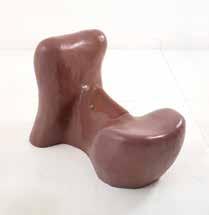
PATRÍCIA GARRIDO
O prazer é todo meu I, 1994
Poliester, silicone, ferro
82 x 55 x 60 cm
Col. Fundação de Serralves Museu de Arte Contemporânea, Porto. Doação da artista em 1997
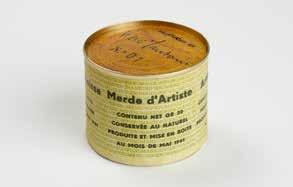
PIERO MANZONI
Merde d’Artiste, 1961
Lata, papel impresso e excrementos. Ed. 1/90
48 x 65 x 65 mm
Livros e Edições de Artista. Col. Fundação de Serralves Museu de Arte Contemporânea, Porto. Doação em 2018
37 36
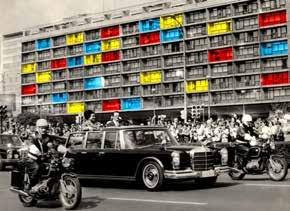
SANJA IVEKOVIĆ
Novi Zagreb (Ljudi iza prozora), 1979
Impressão fotográfica sobre papel. Ed. 2/4 + 2 P.A.
105 x 144,5 cm
Col. Fundação de Serralves Museu de Arte Contemporânea, Porto. Aquisição em 2010
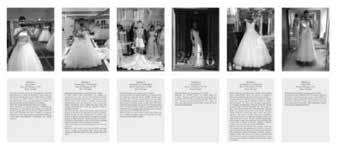
TALES FREY
Vestido, 2014 – 2015
Impressão digital. Registo da performance realizada no Porto, Portugal. Outubro de 2014; Maio de 2015. Fotografias de Tales Frey. Ed. 1/10 + 2 P.A. 50,7 x 120 cm
Col. Fundação de Serralves Museu de Arte Contemporânea, Porto. Doação do artista em 2021
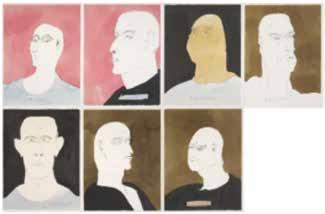
THOMAS SCHÜTTE
Criminali/7 portraits, 1992 Aguarela e lápis sobre papel (7 elementos)
66 x 50 cm (cada)
Col. Fundação de Serralves Museu de Arte Contemporânea, Porto.
Doação de Vicente Todolí em 1998
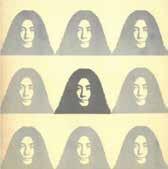
YOKO ONO
Grapefruit, 1981
São Paulo: Edição de autor 15 x 15 cm
Coleção E. M. de Melo e Castro, Col. Fundação de Serralves Museu de Arte Contemporânea, Porto. Adquisição em 2002
39 38
At a time when Portugal is commemorating fifty years of democracy, the Serralves Foundation presents a group exhibition conceived specifically for the Museu de Aveiro/Santa Joana focused on freedom as the driving force of artistic practice. Part of the Aveiro Portuguese Capital of Culture programme, the exhibition brings together works from the Serralves Collection and the Aveiro Municipality Collection, presenting works by artists who question the limits imposed on freedom, whether individual or collective, political or artistic, celebrating acts of emancipation, irreverence and subversion of different forms of control.
The Exercise of Freedom lies at the very origin of artistic practice, running hand in hand with creativity and imagination. In concept, this exhibition could include all kinds of artistic manifestations and therefore, while taking as its theme the celebration of the 50th anniversary of the Carnation Revolution, it is not limited to artistic expressions associated with this important moment in Portuguese history, presenting works from different times, geographies, and disciplines. The works that make up this exhibition have very different origins) from Portugal to Croatia, South Africa, Brazil, Vietnam, or Japan covering more than six decades, spanning from the late 1950s to present day. Reflecting the disciplinary diversity of contemporary art, the exhibition also encompasses the most varied practices, including painting and sculpture, photography and drawing, video and performance, small objects and large installations, posters and postcards, records of actions and even of dreams.
The title of the exhibition relates to the field of action rather than to a mere reflection on the concept of freedom: it refers to its exercise because freedom should be put into practice, exploring its sinuous contours and questioning the limits imposed upon it. After half a century of freedom, is it possible to forget what it means to live without it?
I. Freedom and its opposite
The exhibition begins precisely with a series of works that evoke the deprivation of freedom. The centre of the first room is occupied by a large installation that encloses an inner space which we can see, but cannot access. Inside this fence, with its back turned towards the entrance to the exhibition, hangs a painting that reveals the outlines of a life-size human figure. The balls of soap trapped in the wire mesh of the fence suggest a scene of aggression, although the origin and the target of the attack remain unclear. The result of a collaboration between Miroslav Bałka (Warsaw, Poland, 1958) and Luc Tuymans (Mortsel, Belgium, 1958) two artists whose practices often invoke the trauma and the memory of the Holocaust The Fence (1998) generates a tense relationship between inside and outside, surveillance and security, protection and confinement.
The works shown around this installation reveal other gestures of repression and disobedience. The vitrine in the back wall features documentation from the Archive of Manoel de Oliveira (Porto, Portugal, 1908–2015), relating to the film A Caça [The Hunt] (1964), whose obscure ending Oliveira was forced to change, following the instructions of censorship officials, who ‘demanded an optimistic ending’.1 The apparently inoffensive and effectively silent visual poem Silêncio [Silence] (1970) by the poet and artist E. M. de Melo e Castro (Covilhã, Portugal, 1932–São Paulo, Brazil, 2020) was also prohibited by the Portuguese Censorship Office on four different occasions,2 constituting a remarkable testimony to the revolutionary potential of art.
1 In 1988, when his short film A Caça was being restored by the Cinemateca Portuguesa (Portuguese Film Institute), Oliveira re-edited the film’s ending, inserting the following statement just a few minutes before the tape: ‘In its original version the film ended here but the censorship demanded an optimistic ending as you can see now’. Source: Cinemateca Portuguesa.
2 Interview of Ernesto de Sousa with E. M. de Melo e Castro in the context of the exhibition Concepto Incerto [Uncertain Concept] at the Galeria Buchholz in Lisbon, broadcast in the programme ‘Encontro’ on RTP television channel, on 3 July 1976.
41 40
Ana Hatherly (Porto, 1929 Lisbon, Portugal, 2015), another central figure of the Portuguese Experimental Poetry group,3 produced dozens of drawings from the series to which Escritor [Writer] (c. 1972) belongs, at a time of huge ‘disillusionment [and] outrage’ against the established political and cultural system. This series emerges in this context as a ‘necessary representation of a state of prolonged repression’. In the sinuous and illegible lines of one of these drawings, the artist pens her lament:
‘The words descend over the poet’s face like curtains of water that are closed over the poet’s horrified face. the poet is inside on the inside or else on the outside. the symbol descends over the discovered face. the face of discovery. i sit down on my small glass box which is the page that isolates me and exposes me. the poet’s words appear ascend descend and above all are born. the slowness of the hand is exasperating. i write all this illegibly because i am writing the act of writing the experience of expressing it without expressing. that is attempting this. a thousand writings descend. where do they descend from? they emerge from illegibility. laws on one side laws on the other. all rules to be broken.’4
Closing the first section of the exhibition, the series of drawings Criminali/7 Portraits [Criminals/7 Portraits] (1992) by Thomas Schütte (Oldenburg, Germany, 1954), contains a number of oppositions. Despite being presented by the artist as sketches of prisoners, these watercolour drawings are, in fact, portraits of anonymous people that Schütte encountered in the street and drew from memory. Committed to the social role of art and to questioning the conventions that govern it, Schütte invites us to reflect upon the politics of representation, subverting here the traditional function of the portrait as an artistic genre of glorification, reserved only for illustrious and powerful people.
3 Avant-garde movement from the early 1960s in Portugal, associated with an international trend of artistic and literary transformation that rose up against the narrative constraints of the literary canon and proposed a free experimentation with the visual, phonetic, spatial and material potentialities of language, as a form of poetic and artistic expression. For more information about the PO.EX movement and its antecedents, see the brochure of the exhibition As palavras em liberdade: E. M. de Melo e Castro – O Artista e a sua Coleção, Fundação de Serralves, 2022.
4 Ana Hatherly, ‘Auto-biografia documental’, in Obra Visual 1960 – 1990 Calouste Gulbenkian Foundation, Centro de Arte Moderna, 1992, p. 85.
II. Free circulation
The second segment of the exhibition is dedicated to the work of artists who share a clear political commitment and democratic spirit, weaving into their practices pressing issues in the public sphere that condition our life in society. This nucleus includes a diverse group of prints and editions in different formats, produced en masse and distributed in different circuits, countering the elitist inclination of the art market, and bringing contemporary art practices closer to the daily life of a wider audience.
Works of this nature frequently take the form of posters, at times reproducing iconic works by artists such as Maria Helena Vieira da Silva (Lisbon, Portugal, 1908 Paris, France, 1992) and Augusto de Campos (São Paulo, Brazil, 1931), whose images and mottos marked the end of the dictatorships in Portugal and Brazil; at times, deliberately conceived to occupy the streets, appropriating the public space as a place of intervention and resistance, as is the case with the posters produced by Oficina Arara (Porto, Portugal, 2010) and by the artist Alfredo Jaar (Santiago, Chile, 1956). In other instances, these multiples take the form of objects, such as the glass beaker by Joseph Beuys (Krefeld, 1921 Düsseldorf, Germany, 1986), which measures the growth of a rose, a symbolic image of the gradual transformation of society through creative practice; or the Coca-Cola bottles in which Cildo Meireles (Rio de Janeiro, Brazil, 1948) recorded subversive messages alluding to the Brazilian military dictatorship and consumer society, which were placed in circulation after being collected and resold by the company. The postcards and stamps created by the collectives Guerrilla Girls (New York, USA, 1985) and General Idea (Toronto, Canada, 1967 1994) were also based on the widespread distribution of these formats to convey political messages central to their practices.
43 42
On the other hand, the artist Sanja Iveković (Zagreb, Croatia, 1949) appropriated an image that was widely disseminated in the official media of the Socialist Republic of Yugoslavia, imprinting onto it a subtle gesture of resistance towards the repressive regime that marked the region for four decades. The artist works over a photograph of President Josip Tito’s official visit to Zagreb, in 1979, highlighting a few balconies in the building that appears in the background, where residents can be seen standing, in direct contravention of the security directives issued by the government.
Born in Vietnam in 1975, the artist Danh Võ left the country with his family as a child, fleeing from the war on a boat built by his father, which, although headed to the US, was found by a Danish cargo ship a chance encounter that led the family to emigrate to Denmark, where they were granted asylum and citizenship. Dividing his time today between Berlin and Mexico City, Võ brings with him a unique perspective on questions of identity, migration and belonging. The exhibition features two works from his most famous series, ‘We the People’5 (2011), which is based on a life-size replica of the surface of the Statue of Liberty, fragmented and scattered throughout collections all over the world, evoking the fragility of the concept that the iconic monument is intended to personify. In the case of Ingots (2012), the artist fuses one of the copper fragments into bricks identical to gold bars, though without its distinctive shine, commenting on the constraints associated with the circulation of art and its dependence on the market and the accumulation of wealth.
The relationship between art and capital is also implied in the work Valor [Value] (1977) by António Barros (Funchal, Portugal, 1953), a Portuguese artist associated with the Fluxus movement and the second generation of PO.EX artists, famous for combining language and object in the creation of poetic,
5 The famous opening words of the preamble to the Constitution of the United States of America.
ironic and political works. His poems-objects, or objestos,6 as he called them, give a new meaning to the word and its material platform, based on repetition, fragmentation and the transformation of terms such as cravos-escravos (carnations-slaves), revolução-solução (revolution-solution), ver-verdade (see-truth) and ignorar-orar (ignore-orate/pray).
David Goldblatt (Randfontein, 1930 Johannesburg, South Africa, 2018), a notable photographer famous for his candid depiction of South African society, produced the series ‘Particulars’ in 1975, during the Apartheid regime. Apparently distanced from the brutality of the everyday life of that time, these images focus on details of bodies of different people in public spaces, portraying the positioning of their hands, torso, legs, or feet. Although he initially sought to develop a lyrical body of work, exempt from political implications, the artist quickly understood how the regime of segregation and racial oppression was mirrored in the most natural gestures,7 in the way someone holds their wallet or sits on a park bench. In this context of institutionalised racial segregation, the close-up shots of ‘Particulars’ expose the most intimate and the most far-reaching signs of inequality and repression, status and privilege.
III. It is forbidden to forbid
The famous aphorism Il est interdit d’interdire!, which first appeared as a playful provocation and rapidly became a maxim of the French protest movement of May 1968, serves as the motto for the third and last section of the exhibition, centred on the work of artists for whom irreverence, humour and imagination are profoundly consequential. With wit and audacity, a self-critical stance and utopian spirit, these artists question the constraints of prevailing social rules and oppose any restrictions that are imposed on artistic creation.
6 Freely translated as objestures
7 Interview with David Goldblatt about the series ‘Particulars’, available at steidl.de
45 44
The works of Gretta Sarfaty (Athens, Grece, 1947) and Patrícia Garrido (Lisbon, Portugal, 1963) displayed here, celebrate female sexuality and pleasure with daring and humour. Since the 1970s, Sarfaty has been exploring the deformation of the image of her body as a place of transformation, an investigation that is admirably illustrated in the triptych presented in the show. Rejecting the canonical iconography of the female body, perpetually objectified and subjugated by the male gaze, Sarfaty and several artists of her generation claim for themselves the power to represent and use their body as a means of artistic expression and as a creative and political agent. Patrícia Garrido’s sculptures, entitled O prazer é todo meu [The pleasure is all mine] (1994), are modelled in foam in order to adapt to the artist’s body, being subsequently coated with silicone and polyester in rose tones that lend them their lascivious and carnal appearance. They are intriguing sculptures that appear to have a use, because they are more than ‘negatives of a body’, they are objects of pleasure.
Martha Rosler (New York, USA, 1943) and Tales Frey (Catanduva, Brazil, 1982) reject the normative stereotypes imposed on gender identity, subverting the social roles traditionally prescribed to women and men. In her famous film Semiotics of the Kitchen (1975), Rosler, an artist from the same generation as Gretta Sarfaty, pokes fun at the popular cooking programmes broadcast on television, demonstrating the use of different cooking utensils with violent and bizarre gestures. Tales Frey, a multidisciplinary artist whose practice is rooted in performance, presents the work Vestido [Dress], the documentation of a performative project developed in Porto between 2014 and 2015, in which he visited different wedding clothes stores, attempting on each occasion to try on a dress that, according to heteronormative standards, is traditionally worn by the bride. Frey documents the reactions of each shopkeeper, which varied from complete ease to resolute resistance, at times barring the artist from achieving his goal altogether.
The definition of art, its formats, aims and limits, has been perpetually debated and refuted, especially by its own creators. Questioning and reinventing the raw material of art has entertained artists for generations, paving the way for works such as the infamous tin of excrement by Piero Manzoni (Soncino, 1933 Milan, Italy, 1963) or the minuscule FIMO sculpture by Miguel Branco (Castelo Branco, Portugal, 1963). Language also appears as a common vehicle for gestures of emancipation and provocation, whether taking the form of manifestos, poems, maxims or directives, as illustrated by the works of Ben Vautier (Naples, Italy, 1935), John Baldessari (National City, 1931 Los Angeles, USA, 2020) and James Lee Byars (Detroit, USA, 1932 Cairo, Egypt, 1997), which make use of humour and the absurd to demonstrate that art is, after all, whatever the artist makes of it.
However, questioning figures and structures of power also means challenging the artist’s authority as a creative genius. Various artists share the authorship of their works with their audience, as is the case with Pele Compulsiva [Compulsive Skin] (2000) by Fernando J. Ribeiro (Lisbon, Portugal, 1963): here, the object modelled by the artist is merely a platform for the performative action of visitors, who are encouraged to scribble on it with total freedom. As a pioneer of participative performance, Yoko Ono (Tokyo, Japan, 1933) relies upon the physical and mental dexterity of each visitor (or reader) to complete the instructions that she leaves in her famous book Grapefruit (1964), many of which can only be realised in the field of imagination. This is precisely where The Exercise of Freedom comes to its end in the world of imagination with the utopian dream of Fernando Lanhas (Porto, Portugal, 1923 2012) and the cosmic fables of António Costa Pinheiro (Moura, Portugal, 1932 Munich, Germany, 2015), following the motto that this visionary artist embossed onto several of his fantastic works:
‘Imagination is our freedom’.8
8 Stamp with the inscription ‘L’imagination est notre liberté’ used by the artist in various works from the series that comprises the artworks presented in this exhibition.
47 46

48
PATRÍCIA GARRIDO
O prazer é todo meu I, 1994
LER READ
W. E. B. Du Bois, The Souls of Black Folk, Chicago: A. C. McClurg & Co., 1903 (São Paulo: Veneta, 2021)
Jean-Paul Sartre, L’Être et le Néant, Paris: Éditions Gallimard, 1943 (Coimbra: Edições 70, 2021)
Hannah Arendt, The Origins of Totalitarianism, Nova Iorque: Schocken Books, 1951 (Lisboa: Dom Quixote, 2024)
Maria Isabel Barreno, Maria Velho da Costa e Maria Teresa Horta, Novas Cartas Portuguesas, Lisboa: Estúdios Cor, 1972
Audre Lorde, Sister Outsider, Berkeley: The Crossing Press, 1984
Antonio Tabucchi, Sostiene Pereira, Milão: Feltrinelli, 1994 (Lisboa: Dom Quixote, 2015)
Às Artes, Cidadãos!, cat. exp., Porto: Fundação de Serralves, 2011
Angela Davis, Freedom is a Constant Struggle, Chicago: Haymarket Books, 2016 (Lisboa: Antígona, 2020)
Zero em comportamento, cat. exp., Porto: Fundação de Serralves, 2018
Shahd Wadi, Corpos na Trouxa, Coimbra: Edições Almedina, 2017
Ailton Krenak, Ideias para adiar o fim do mundo, São Paulo: Companhia das Letras, 2019
What about Activism? (ed. Steven Henry Madoff), Londres: Sternberg Press, 2019
VER SEE
Charlie Chaplin, The Great Dictator, 1940
Manoel de Oliveira, A Caça, 1964
François Truffaut, Fahrenheit 451, 1966
Alberto Seixas Santos, Brandos Costumes, 1975
Julie Dash, Daughters of the Dust, 1991
Roberto Benigni, La vita è bella, 1997
Wong Kar-Wai, 2046, 2004
Yorgos Lanthimos, The Lobster, 2015
Jordan Peele, Get out, 2017
Catarina Vasconcelos, A Metamorfose dos Pássaros, 2021
Dania Bdeir, Warsha, 2022
OUVIR LISTEN
Ludwig van Beethoven, Sinfonia n.º 9, 1824
Bella Ciao, c. 1940
Miriam Makeba, Beware, Verwoerd! (Ndodemnyama), 1965
Nina Simone, I Wish I Knew How It Would Feel to Be Free, 1967
Cateano Veloso, É Proibido Proibir, 1968
Sheikh Imam, Ya Falasteeniya, 1968
Zeca Afonso, Grândola, Vila Morena, 1971
Queen, I Want to Break Free, 1984
Patti Smith, People Have The Power, 1988
Luisa Cunha, FRYDM!, 2011
Beyoncé feat. Kendrick Lamar, Freedom, 2016
A Coleção de Serralves centra-se na arte contemporânea produzida desde os anos 1960 até à atualidade, distinguindo-se pela perspetiva internacional que proporciona sobre a arte portuguesa produzida desde esse período histórico de mudanças políticas, sociais e culturais a nível planetário. Cumprindo o seu programa de pesquisa e desenvolvimento permanentes, a Coleção de Serralves mantém uma aturada atenção à criação do século XXI, em particular à relação das artes visuais com a performance, a arquitetura e a contemporaneidade no âmbito de um presente pós-colonial e globalizado.
A Coleção de Serralves integra obras que são propriedade da Fundação de Serralves, incluindo um importante núcleo de livros e edições de artistas, e obras provenientes de várias coleções privadas e públicas que foram objeto de depósitos de longo prazo. De entre os acervos depositados em Serralves que constituíram pontos de referência para o seu desenvolvimento contam-se a Coleção de Arte Contemporânea do Estado (CACE) e a coleção da Fundação Luso-Americana para o Desenvolvimento (FLAD).
A presente mostra integra-se no programa de exposições e apresentação de obras da Coleção de Serralves, especificamente selecionadas para os locais de exposição com o objetivo de tornar o acervo acessível a públicos diversificados de todas as regiões do país.
The Serralves Collection focuses on contemporary art spanning from the 1960s to the present, offering an international perspective on Portuguese art since that historical period, which was marked by worldwide political, social and cultural change. In line with its continuous research and development programme, the Serralves Collection follows attentively the developments in twenty-first century creation, particularly in regard to the relationship between the visual arts and performance, architecture and contemporaneity in the context of a post-colonial, globalised present.
The Serralves Collection includes works that belong to the Serralves Foundation, including a significant corpus of artists’ books and publications, as well as works on long-term loan from several public and private collections, which were crucial references for its formation, such as the Portuguese State Contemporary Art Collection (CACE) and the Luso-American Development Foundation (FLAD) Collection.
The Exercise of Freedom is part of a programme of exhibitions and presentation of artworks from the Serralves Collection that are specifically selected for each location with the purpose of making the collection accessible to the public across all regions in the country.
51 50
COLEÇÃO DE SERRALVES FORA DE PORTAS FUNDAÇÃO DE SERRALVES MUSEU DE ARTE CONTEMPORÂNEA
No momento em que comemoramos cinquenta anos de democracia, a Fundação de Serralves apresenta uma exposição coletiva concebida especificamente para o Museu de Aveiro/Santa Joana que se desenvolve em torno da liberdade enquanto força motriz da criação artística. Integrada na programação Aveiro Capital Portuguesa da Cultura e reunindo obras da Coleção de Serralves e da Coleção do Município de Aveiro, a exposição apresenta trabalhos de artistas que questionam os limites impostos sobre a liberdade individual e coletiva, política e artística, celebrando atos de emancipação, irreverência e subversão de diferentes formas de controlo.
As we celebrate fifty years of democracy in Portugal, the Serralves Foundation presents a group exhibition conceived specifically for the Museu de Aveiro/Santa Joana focused on freedom as the driving force of artistic creation. As part of the Aveiro Portuguese Capital of Culture programme and bringing together works from the Serralves Collection and the Aveiro Municipality Collection, the exhibition features works by artists who question the limits imposed on freedom, whether individual or collective, political or artistic, celebrating acts of emancipation, irreverence and subversion of different forms of control.
www.serralves.pt
CÂMARA MUNICIPAL DE AVEIRO | MUSEU DE AVEIRO / SANTA JOANA AVENIDA DE SANTA JOANA, 3810-164 AVEIRO
CONTACTOS CONTACTS
+351 234 423 297 / +351 234 406 485 | museusdeaveiro@cm-aveiro.pt | www.cm-aveiro.pt
HORÁRIO SCHEDULE
Terça a Domingo Tuesday to Sunday: 10h00 — 12h30 e and 13h30 — 18h00
52
Apoio Institucional Institutional Support











































